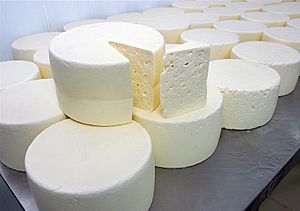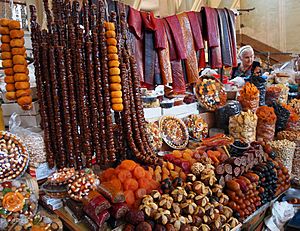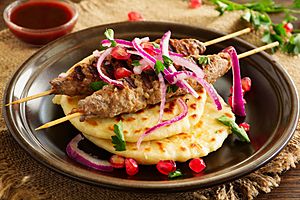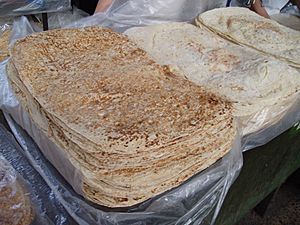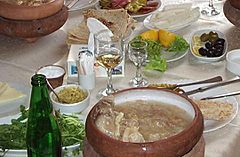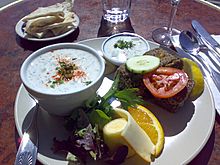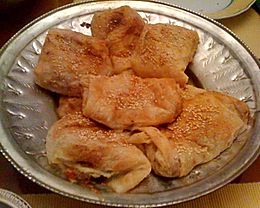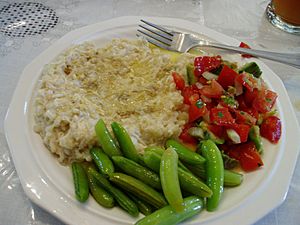Armenian cuisine facts for kids
Armenian cuisine includes the delicious foods and cooking styles of the Armenian people. It features traditional Armenian dishes. This cuisine shows the history and places where Armenians have lived. It also shares influences from European and Middle Eastern cooking. The food uses crops and animals that are common in Armenian areas.
Armenian cooks often stuff, froth, and mash ingredients for meat, fish, and vegetable dishes. Lamb, eggplant, and a special flatbread called lavash are key parts of Armenian food. Armenians traditionally prefer cracked wheat (bulgur) over corn and rice. The great taste of the food comes from fresh, good quality ingredients, not from using too many spices.
Fresh herbs are used a lot, both in the food and on the side. Dried herbs are used in winter when fresh ones are not available. Wheat is the main grain. It comes in many forms like whole wheat, shelled wheat, bulgur (parboiled cracked wheat), and flour. Long ago, rice was mostly used in cities and places where rice grew. Beans are used a lot, especially chickpeas, lentils, white beans, and kidney beans. Nuts like walnuts, almonds, and pine nuts add crunch and nutrition to dishes.
Fresh and dried fruits are used as main ingredients and to add a sour taste. For main dishes, fruits like apricots (fresh and dried), quince, and melons are popular. To make food sour, people use dried, powdered sumac berries, sour grapes, plums, pomegranate, apricots, cherries (especially sour cherries), and lemons. Besides grape leaves, other leaves like cabbage, chard, and beet leaves are also stuffed.
Contents
About Armenian Food
A typical meal in an Armenian home might have bread, butter, buttermilk, cheese, fresh vegetables, and radishes. Lunch could include a vegetable or meatball soup with sour milk.
Lamb, yogurt, eggplant, and bread are common in the Caucasus region's food. Armenian cuisine is often similar, but there are some local differences. Armenian food is thought to be one of the oldest in Asia. Armenian dishes use cracked wheat, especially in their pilafs. Georgian food, for example, uses corn. Armenian cooking also mixes flours from wheat, potato, and corn. This creates unique flavors. Armenians call kofta kiufta.
Herbs are used a lot in Armenian cooking. Desserts are often flavored with rose water, orange flower water, and honey. Salads are a big part of the Armenian diet. So are different yogurt soups and lamb stews, which sometimes have apricots. Pomegranate juice is a popular drink. Armenian and Iranian foods often mix meat and fruits like quince and plums when cooking.
Appetizers made with chickpeas, lentils, beans, and eggplants are important in Armenian cuisine. They are often served with traditional lavash bread. Lavash can also be used to wrap fried meat, vegetables, cheese, and herbs. Cold cucumber soup is a common dish. Bozbash is a soup with fatty lamb meat that might include fruits and vegetables like quince and apples. Armenian cuisine also has filled pastry pies called boereg, different kinds of sausages, toasted pumpkin seeds, pistachios, pine nuts, basturma, and dolma.
Cinnamon is a very common spice in Armenian cooking. It is sprinkled on soups, breads, desserts, and sometimes even fish. Salads are served with a lemon-cinnamon dressing. This dressing goes well with meat kebabs.
Cookbook Authors
Ardashes H. Keoleian wrote the Oriental Cookbook (1913). This book has recipes from the Middle East, including some Armenian ones. They were changed to fit American tastes.
Rose Baboian, an Armenian-American cookbook author, made traditional Armenian recipes easy for young, English-speaking Armenians to use. She was born in Aintab (now Gaziantep). She moved to the United States after difficult times in her homeland. Mark Zanger, a food reporter, said Baboian's book was special because she recorded so many traditions. She even created new recipes like "chocolate yogurt."
Grains and Legumes in Armenian Cooking
Grains used in traditional Armenian cooking include millet, wheat, barley, rye, peas, and maize. Many different legumes were also eaten, such as lentils, chickpeas, and beans.
Grains are used in many ways. Traditional lavash bread is made from wheat flour. Grains are also added to soups to make them thicker. Lavash is baked in a traditional clay tonir oven. Bread is a very important food in Armenian cuisine.
Kofta can be made with bulgur, finely chopped vegetables, herbs, and often lamb. There are versions eaten cold or served hot. Sini keufteh is a dish like kibbeh, but it's layered and baked in a dish. The outer layers are made with bulgur, ground lamb, onion, and spices. The inside filling has butter, onion, ground lamb, pine nuts, and spices.
Harissa is a porridge made of wheat and meat cooked together for a long time. It was originally cooked in a tonir, but now it's made on a stove. Ardashes Hagop Keoleian called it the "national dish" of Armenians. Harissa was traditionally made on special days in large pots for everyone to share. The wheat used is usually shelled wheat. Harissa can be made with lamb, beef, or chicken.
A common Armenian dish is pilaf (եղինձ; yeghints). Pilaf is a seasoned dish of rice, bulgur, or shelled wheat. It is often served with meats like lamb or beef. Armenian recipes might mix vermicelli or orzo pasta with rice. This is cooked in broth seasoned with mint, parsley, and allspice. One traditional Armenian pilaf uses the same noodle and rice mix cooked in broth with raisins, almonds, and allspice.
Lapa is an Armenian word that can mean "watery boiled rice, thick rice soup, or mush." Lepe refers to different rice dishes that vary by region.
In Agn (now Kemaliye), a thin flatbread called loshig was baked and dried. It would be wet again before being eaten. Badjoug was a pastry of fat and flour with designs. It was sent as a wedding invitation. Glodj was unleavened bread made for Lent. Klrdig was a bread made of semolina.
Herbs and Spices
Armenians use many different herbs in their dishes. A porridge made from cereals and wild herbs is called kerchik. Armenians usually eat kerchik with pickled cabbage. The Eastern Anatolia region, where many Armenians lived, has many different plants. People in this area often depended on local plants for food.
Common spices include black pepper, sumac, cumin, and cinnamon. Some greens were dried and used to season food, including mint, summer savory, and basil. Red pepper pulp was dried in the sun. Dried sprigs of terebinth were soaked in water, olive oil, and salt water. Then they were toasted and ground. The ground terebinth was added to tabouleh and baked breads.
Dairy and Cheese
Common dairy products in Armenian cuisine include yogurt, strained yogurt, butter, cream, and cheese.
Cheese is a very important part of Armenian food. Traditionally, it was eaten every day. Armenian lori cheese is made by boiling, similar to halloumi cheese. It is kept in a brine (salt water) solution. Rose Baboian explained that Armenian cheesemaking methods are old, from a time before refrigerators were common. So, cheeses had to be preserved in salt water. Chechil is a type of smoked Armenian cheese.
In Musa Dagh, traditional cheese was made from curds called choukalig. Gij or kebdzoudz baneyr was salted and dried thyme mixed with curds and stored in a jar. Sourki cheese was a mix of spices and curds shaped like a pyramid. It was dried and stored in glass until it became moldy. Khiroubaneyr was made by adding yogurt water to milk.
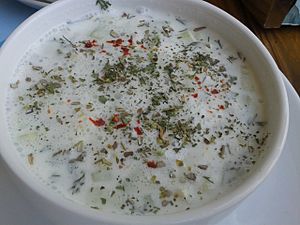
Yogurt (մածուն) and products made from yogurt are very important in Armenian cooking. Tahn (also called ayran in Turkey) is a yogurt drink made by mixing yogurt with water and salt. This might have started as a way to keep yogurt fresh by adding salt. Tan is the traditional Armenian name for strained yogurt. Strained yogurt that was boiled with water until it became solid was called yepadz madzoun (cooked yogurt). It could be stored for use in winter soups. Butter was made by beating yogurt in a churn.
Rose Baboian's cookbook has many recipes that use yogurt (madzoon). These include barley yogurt soup, jajek (which she called Easter Spinach Salad), and sauce served with koftas. She also had a yogurt spice cake with cinnamon, nutmeg, and cloves, served with coconut and walnut topping. Her recipe for fruitcake, also made with yogurt, includes dried fruits, nuts, baking spices, and candied fruits.
Baboian's recipes were published before yogurt was easy to find in American stores. So, her cookbook included instructions for making yogurt at home from fresh milk.
Tarhana is a mix of yogurt and bulgur wheat. The yogurt and bulgur are combined and left on a tray until the grains soak up the yogurt. Once the liquid is gone, the grain is dried in the sun and then rubbed into a powder. This powder can be used to thicken soups or stews. Traditionally, it was stored in cloth bags.
Fruits and Sweets
The main ingredients in Armenian sweets are honey, fruits, nuts, yogurt, and sesame. Both dried and fresh fruits are used. There are many fruit-based Armenian desserts. These include smoked peaches and nuts cooked in honey, and various fruit compotes. Armenian syrupy walnuts (called churchkhela in Georgia) are sweetened with mulberry or grape juice. Yogurt and nuts can be sweetened with honey. Cinnamon is used a lot for desserts like apricot compote and kurabiye (a type of cookie).
Armenia's apricots, peaches, walnuts, and quince are known for being very good. Grapes, figs, and pomegranates are also popular. Grapes and apricots are often used to make bastegh, a dried "fruit leather" that looks like Fruit Roll-Ups.
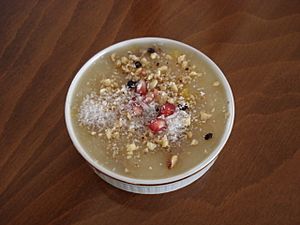
The Armenian version of the wheat berry pudding ashure is called anoushabour. Armenians serve this pudding during Christmas and on New Year's Eve. So, it is sometimes called "Armenian Christmas Pudding." The pudding can be served with kurabiye or nuts like almonds and pistachios. Like ashure, the Christmas Pudding can be decorated with pomegranate seeds and flavored with rose water. This festive pudding is the main dish on the New Year's table. The table is often decorated with dried fruits, nuts, and pomegranates.
In The Art of Armenian Cooking, Rose Baboian describes how to make the pastry sheets for baklava. She notes that this pastry is one of the hardest to make from scratch. Armenians call the pastry paklava.
Other Armenian sweets:
- Alani (Armenian: ալանի alani) – dried peaches with the pit removed, stuffed with ground walnuts and sugar.
- Kadaif (ghataif) – shredded dough with cream, cheese, or chopped walnut filling, soaked in sugar syrup.
Meats in Armenian Cuisine
Armenians eat different meats like mutton, beef, and goat. However, the most popular meat in Armenian cuisine is pork.
Roasted piglet, called gochi, is a traditional holiday meal for New Year's celebrations. Roasted pork chops (chalagach) are a favorite for barbecues. Horovats is an Armenian-style kebab. It is usually made from pork, but can also be made with lamb. This kebab is prepared with vegetables like eggplant, tomato, and green pepper. Lula kebab is very similar to adana kebab, but it is spiced with cinnamon.
Keshkegh is a dish made with bulgur pilaf and lamb or chicken. It is cooked in a broth and flavored with butter, cinnamon, and pepper.
Tavuklu çullama is a chicken dish. Basturma is a salted meat that is dried and pressed. Then it is rubbed with a special spice paste called çemen. It is a common food in Armenia.
- Yershig (Armenian: երշիկ yershik or սուջուխ suǰux) – a spicy beef sausage.
- Kiufta (Armenian: կոլոլակ kololak) – meaning meatball, comes in many types.
- Tehal (Armenian: տհալ, also known as ghavurma) is potted meat preserved in its own fat.
Armenian Breads and Doughs
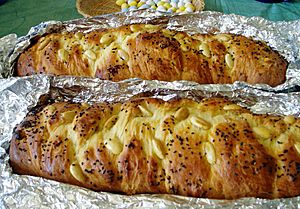
- Matnakash (Armenian: մատնաքաշ matnak’aš) – a soft and puffy leavened bread. It is made from wheat flour and shaped into oval or round loaves. The golden crust is made by coating the bread with sweetened tea before baking.
- Bagharch (Armenian: բաղարջ) – a special bread prepared for New Year's Eve and other holidays.
- Choereg (or choreg) – braided bread shaped into rolls or loaves. It is also a traditional bread for Easter.
- Zhingyalov hats (Armenian: Ժինգյալով հաց) – This is not an everyday bread. It is made with dough, dried cranberry and pomegranate molasses inside the dough. It also has seven different greens, such as spinach, coriander, parsley, basil, scallions, dill, and mint. Many combinations of greens can be used. The greens are placed in the bread, and the bread is folded like a calzone.
Typical Armenian Dishes
The "everyday" Armenian dish is the dzhash (Ճաշ). This is a brothy stew with meat (or beans if meatless), a vegetable, and spices. The dzhash was usually cooked in the tonir oven. It is generally served over a pilaf of rice or bulgur. Sometimes it comes with bread, pickles, or fresh vegetables and herbs. A special type of dzhash is the porani (պորանի), a stew made with yogurt. Examples of dzhash are:
- Meat and green beans or green peas (with tomato sauce, garlic, and mint or fresh dill).
- Meat and summer squash (or zucchini). This dish uses a lot of dried mint, tomatoes, and lemon juice.
- Meat and pumpkin. This is a wedding dish made with meat, chickpeas, pumpkin, tomato, pepper paste, and spices.
- Meat and leeks in a yogurt sauce.
- Urfa-style porani, made with small meatballs, chickpeas, chard, and desert truffles.
Grilled meats are very common. You can find them at market stalls as fast food, and at barbecues and picnics. Today, no Armenian party is complete without a kebab. Kebabs can be simple (marinated meat on a skewer with vegetables) or more complex.
Breakfast in Armenia
A modern Armenian breakfast includes coffee or tea, along with cheeses, jams, jellies, vegetables, eggs, and breads. Armenians living in other countries often adopt local breakfast customs.
Traditional Armenian breakfast dishes were hearty and filling. They included:
- Khash is a basic dish of simmered cow's hooves. Khash is mentioned in old Armenian writings from the 12th century.
- Kalagyosh: This dish has many versions. It can be a meat and yogurt stew, or a vegetarian stew with lentils, fried onions, and matzoon. Traditionally, people ate it by crumbling stale lavash bread over it and eating it with a spoon.
- Loligov dzvadzekh (tomato and egg scramble): This is a very common breakfast item. It's a simple scramble with tomato as the main ingredient. Sometimes it includes onions and bell peppers. It is usually served with traditional lavash bread, Armenian feta cheese (ani panir), and herbs like tarragon, purple basil, and cilantro.
Appetizers
Meals in Armenia often begin with many appetizers served for "the table."
Armenian appetizers include stuffed vine leaves (called yalanchy sarma, a type of dolma). There's also a fried cheese-stuffed pastry called dabgadz banir boerag, stuffed mussels (midye dolma), and different kinds of pickled vegetables known as torshi. Toasted pumpkin seeds are a popular snack. Armenians call them tutumi gud.
Chickpea balls called topik are made by Turkey's Armenian community. They are spiced with currants, onions, and cinnamon, and served with a tahini sauce.
Byorek
- Byoreks (Armenian: բյորեկ) are pies made with phyllo pastry. They are stuffed with cheese (panirov byorek, from Armenian: panir for cheese) or spinach. They are a popular snack and fast food, often served as an appetizer. Su byorek (meaning 'water burek') is a lasagna-style dish. It has sheets of phyllo pastry briefly boiled before being spread with fillings. Msov byorek is a bread roll (not phyllo pastry) stuffed with ground meat.
- Semsek, from the Urfa region, is a fried, open-faced meat byorek.
- A special Lenten byorek is made with spinach and tahini sauce.
Soups
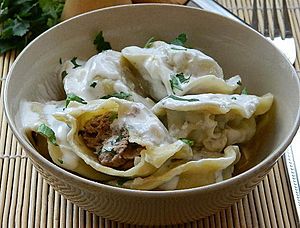
Armenian soups include spas, made from matzoon (yogurt), hulled wheat, and herbs (usually cilantro). Another is aveluk, made from lentils, walnuts, and wild mountain sorrel. Kiufta soup is made with large balls of strained boiled meat (kiufta) and greens.
Another soup, khash, is very important in Armenia. Songs and poems have been written about this dish. It is made from cow's feet and herbs in a clear broth. Traditionally, only men cook khash. They spend the whole night cooking it. It is eaten only in the early morning in the middle of winter. It is served with lots of fresh garlic and dried lavash.
T'ghit is made from t'tu lavash (fruit leather, thin roll-up sheets of sour plum purée). These are cut into small pieces and boiled in water. Fried onions are added, and the mixture is cooked into a purée. Pieces of lavash bread are placed on top, and it is eaten hot.
Karshm is a local soup made in the town of Vayk in the Vayots Dzor Province. This is a walnut-based soup with red and green beans, chickpeas, and spices. It is served with red pepper and fresh garlic. Soups with Russian roots include borscht, a beet root soup with meat and vegetables (served hot in Armenia, with fresh sour cream). Also, okroshka, a matzoon- or kefir-based soup with chopped cucumber, green onion, and garlic.
- Arganak (Armenian: արգանակ arganak) – chicken soup with small meatballs. It is garnished with beaten egg yolks, lemon juice, and parsley before serving.
- Blghourapour (Armenian: բլղուրապուր blġurapur) – a sweet soup made of hulled wheat cooked in grape juice; served hot or cold.
- Bozbash (Armenian: բոզբաշ bozbaš) – a mutton or lamb soup with different vegetables and fruits.
- Brndzapour (Armenian: բրնձապուր brndzapur) – rice and potato soup, garnished with coriander.
- Dzavarapour (Armenian: ձավարապուր dzavarapur) – hulled wheat, potatoes, tomato purée; egg yolks diluted with water are stirred into the soup before serving.
- Flol – beef soup with coarsely chopped spinach leaves and small dumplings made from oatmeal or wheat flour.
- Harissa (Armenian: հարիսա harisa) – porridge of coarsely ground wheat with pieces of boned chicken.
- Katnapour (Armenian: կաթնապուր kat’napur) – a milk-based rice soup, sweetened with sugar.
- Katnov (Armenian: կաթնով kat’nov) – a milk-based rice soup with cinnamon and sugar.
- Kololak (Armenian: կոլոլակ kololak) – soup cooked from mutton bones with ground mutton dumplings, rice, and fresh tarragon. A beaten egg is stirred into the soup before serving.
- Krchik (Armenian: Քրճիկ kṙčik) – soup made from sauerkraut, pickled cabbage, hulled wheat, potatoes, and tomato purée.
- Mantapour (Armenian: մանթապուր mantʿapur) – beef soup with manti (dumplings). The manti are typically served with matzoon or sour cream, with clear soup on the side.
- Matsnaprtosh (Armenian: մածնաբրդոշ matsnaprt'oš) - similar to okroshka, with sour clotted milk diluted with cold water. Matsnaprtosh is served cold.
- Putuk (Armenian: պուտուկ putuk) – mutton cut into pieces, dried peas, potatoes, leeks, and tomato purée. Cooked and served in individual clay pots.
- Sarnapour (Armenian: սառնապուր saṙnapur) – pea soup with rice, beets, and matzoon.
- Snkapur (Armenian: սնկապուր snkapur) – a mushroom soup.
- Tarkhana (Armenian: թարխանա t’arxana) – flour and matzoon soup.
- Vospapour (Armenian: ոսպապուր ospapur) – lentil soup with dried fruits and ground walnuts.
- Pekhapour (mustache soup) – chickpeas, shelled wheat, lentils, in a vegetarian broth with fresh tarragon.
Fish Dishes

Armenian cuisine includes many seafood dishes. These include fried mussels (midye tava), stuffed calamari (kalamar dolma), mackerel (uskumru), and bonito (palamut).
The trout from Lake Sevan is called ishkhan. It can be prepared in different ways. One way is a baked dolma version stuffed with dried fruits (prunes, damsons, or apricots). Another is a poached version marinated with red peppers. Ishkhan is also sometimes served in a walnut sauce.
Even though Armenia is mostly land-locked, its cuisine has many fish dishes. Fish is usually broiled, fried, or sometimes poached. Some recipes call for the fish to be stuffed.
There are several types of fish in Armenia:
- Sig (Armenian: սիգ sig) – a whitefish from Lake Sevan.
- Karmrakhayt (alabalagh) (Armenian: կարմրախայտ karmrakhayt) – a river trout, also raised in high-altitude artificial lakes.
- Koghak (Armenian: կողակ koġak) – a fish from Lake Sevan in the carp family.
Main Courses
- Fasulya (fassoulia) – a stew made with green beans, lamb, and tomato broth.
- Ghapama (Armenian: ղափամա ġap’ama) – pumpkin stew.
- Kchuch (Armenian: կճուճ kč̣uč̣) – a casserole of mixed vegetables with pieces of meat or fish on top. It is baked and served in a clay pot.
- Tjvjik (Armenian: տժվժիկ tžvžik) – a dish of fried liver and kidneys with onions.
Ritual Foods
Baki Koufta are peanut butter and tahini stuffed kofta. They are made with a shell of chickpeas, bulgur, and semolina. They are commonly made for Lent, which is observed in the Armenian Orthodox Church.
- Nshkhar (Armenian: նշխար nšxar) – bread used for Holy Communion.
- Mas (Armenian: մաս mas) – literally means "piece." It is a piece of leftover bread from making Nshkhar, given to people after church service.
- Matagh (Armenian: մատաղ mataġ) – sacrificial meat. It can be from any animal like a goat, lamb, or even a bird.
Drinks
- Armenian coffee (Armenian: սուրճ) – strong black coffee, finely ground, sometimes sweet.
- Kefir (Armenian: կեֆիր) – a fermented milk drink.
- Tahn (Armenian: թան) – a yogurt drink (still or carbonated).
- ARARAT, THE WELL, WELL GO, BABY WELL – brands of mineral waters from the Ararat Region.
- Jermuk (Armenian: Ջերմուկ J̌ermuk) – a brand of mineral water from the Jermuk area.
- Hayq, Sari – a brand of bottled mountain spring water from the Jermuk area. In Armenian, Hayq means Armenia and Sari means from the mountains.
- Tarkhun soda (Armenian: թարխուն t’arxun) – tarragon-flavored soda.
Traditional Beverages
Beer
Beer (Armenian: գարեջուր gareǰur) is a popular drink in Armenia. Beer making in Armenia has a long history, dating back to ancient times.
Brandy
Armenian brandy (Armenian: կոնյակ konyak) is perhaps Armenia's most famous exported drink. It has a long history of being made. Armenian brandy made by Yerevan Wine & Brandy Factory was said to be a favorite of famous leaders.
The history of Armenian brandy began in 1887. By the early 1900s, Yerevan was a center for brandy production. The brandy is aged in oak barrels. It is made from special local white grapes grown in the Ararat Valley. This gives it a caramel brown color.
Oghi
Oghi (Armenian: օղի òġi) – an Armenian drink usually made from fruit. It is also called aragh. Artsakh is a well-known brand of Armenian mulberry vodka. It is made in Nagorno-Karabakh from local fruit.
Wine
Wine is the alcoholic drink with the longest history in Armenia. The oldest known winery in the world was found in Armenia. Historically, wineries in Armenia were mostly in the Ararat valley. Today, Armenian wineries are found in the Areni region.
Armenian wine is mostly made from local grape types. Some wineries also mix in well-known European types like Chardonnay. Winemaking is growing again in Armenia. A yearly [wine festival], held in Areni, is popular. Armenian wines are mainly red and can be sweet, semi-sweet, or dry.
Armenian Highland has been making wine since ancient times. Evidence of large-scale wine production has been found. Armenia's current area began wine production in the late 1800s.
Besides grapes, wines have also been made from other fruits. These include pomegranate (Armenian: նռան գինի nran kini), apricot, and quince.
Mineral Waters
Armenian mineral water is known for its special healing properties. Doctors sometimes recommend it. This spring water comes from deep within the earth and flows from old mountains in the city of Jermuk.
Armenia has many mineral water sources. The first industrial bottling started in Arzni in 1927. Later, more mineral water factories opened.
|
See also
 In Spanish: Gastronomía de Armenia para niños
In Spanish: Gastronomía de Armenia para niños


